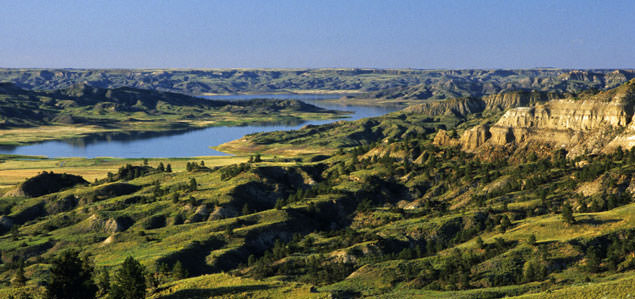
Jordan Country
By Rick and Susie Graetz
Late 1800’s photographer L. A. Huffman called it "The Big Open," National Geographic termed it "Jordan Country" and others refer to the sparsely populated country south of Fort Peck Lake as “The Big Dry." The small ranching town of Jordan is the heart of this scenic territory.
Rising from the banks of Big Dry Creek and straddling MT Hwy 200, Jordan was founded in about 1896 by Arthur Jordan. He asked that the town take the name of a friend from Miles City who was also named Jordan. The first residence was Arthur Jordan's tent. Later, he established a post office and store for this fledgling cow town.
Jordan and the surrounding expanse of rangeland is still very much cowboy country and the place retains an old west flavor. False-front buildings on main street haven’t changed much since the communities earliest days ... some are over 80 years old.
This seat of Garfield County is your entry to some of the most remote and beautiful mix of deep river canyons, badlands and prairie wilderness in the west. The most rugged of the terrain is part of the 1.1 million-acre Charles M. Russell Wildlife Refuge, which surrounds Fort Peck Lake in a 200-mile long strip. And wildlife abounds out here ... antelope, elk, mule deer, whitetail deer, wild turkeys, sage grouse and numerous waterfowl make these wildlands their home. Before heading into this inviting region, it's best to travel beyond Jordan to get an overview of the landscape to the east and northeast of the town.
From Jordan, drive east on MT 200 toward Circle. Fifteen miles out, you'll enter a ten-mile stretch of very spectacular views of red and yellow colored buttes, badlands and distant vistas. Farther yet, 36 miles from town, you’ll encounter Hwy 24 pointing north, which parallels the Dry Arm section and eastern edge of Fort Peck Lake. If you'd like to camp, put a boat in the water, or just see the lake, take advantage of the recreation areas along the its length; there are several and they are well marked. The Sand Arroyo badlands found here are fascinating. Remember, most of the roads to these places are only passable when it is dry.
After your visit to Dry Arm, stay in Jordan a couple of days or camp in the Missouri Breaks. There are many roads and trails throughout this river wilderness, but before striking out, inquire at the Charles M. Russell Wildlife Refuge office in town. They can advise you on conditions and regulations on the Refuge and the best routes to follow. Understanding the roads and knowing the weather forecast will add to the success of your trip. Getting hung up in the gumbo created by wet weather is not a pleasant surprise.
The terrain east and north of Jordan is famous among paleontologists for its fantastic fossil beds. Dinosaurs and pre-historic creatures once roamed here. In 1904, a Tyrannosaurus Rex was discovered in the Hell Creek Formation. See the dinosaur display in the museum while in town.
Hell Creek State Park, on Fort Peck Lake, 26 miles north of Jordan is a popular area. On the way there you'll go through the stately piney buttes and high rises on the road that offer excellent views of some of the upper reaches of the Missouri Breaks and the CMR Refuge. Devil's Creek, Snow Creek and Crooked Creek, all north of Jordan, are worthwhile places to explore. The Haxby Road east of Jordan reaches a long way out through the badlands and into the breaks.
This is a place that will amaze you ... it is truly uncommon and one of the most fantastic wilderness regions of America.




